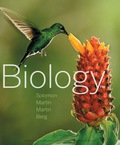
EBK BIOLOGY
11th Edition
ISBN: 8220106820636
Author: Martin
Publisher: CENGAGE L
expand_more
expand_more
format_list_bulleted
Concept explainers
Question
Chapter 45.6, Problem 3C
Summary Introduction
To describe: The way by which an autoimmune disease develops.
Introduction: Autoimmune disorders are the disorder or a disease condition in which the immune system attacks the own body cells mistakenly due to the inability to make a distinction between self and non-self-cells. In this case, the antibodies attack the individual’s own tissue and cells. Such antibodies are termed as autoantibodies.
Expert Solution & Answer
Want to see the full answer?
Check out a sample textbook solution
Students have asked these similar questions
Please draw in the missing answer, thank you
Please fill in all blank questions, Thank you
please fill in missing parts , thank you
Chapter 45 Solutions
EBK BIOLOGY
Ch. 45.1 - Prob. 1LOCh. 45.1 - Compare, in general terms, the immune responses...Ch. 45.1 - Prob. 1CCh. 45.1 - In general, how are vertebrate immune responses...Ch. 45.2 - Describe innate immune responses, including...Ch. 45.2 - Prob. 1CCh. 45.2 - Prob. 2CCh. 45.2 - Prob. 3CCh. 45.2 - VISUALIZE Draw a diagram illustrating the main...Ch. 45.3 - Prob. 4LO
Ch. 45.3 - Prob. 5LOCh. 45.3 - How are cell-mediated immunity and...Ch. 45.3 - Prob. 2CCh. 45.3 - Prob. 3CCh. 45.4 - Describe the sequence of events in cell-mediated...Ch. 45.4 - Prob. 1CCh. 45.5 - Summarize the sequence of events in...Ch. 45.5 - Prob. 8LOCh. 45.5 - Prob. 9LOCh. 45.5 - Prob. 10LOCh. 45.5 - Prob. 1CCh. 45.5 - Prob. 2CCh. 45.5 - Prob. 3CCh. 45.5 - Prob. 4CCh. 45.6 - Prob. 11LOCh. 45.6 - Describe examples of hypersensitivity, including...Ch. 45.6 - Prob. 1CCh. 45.6 - Prob. 2CCh. 45.6 - Prob. 3CCh. 45.6 - Prob. 4CCh. 45.6 - What is the immunological basis for graft...Ch. 45 - Innate immune responses include all but (a)...Ch. 45 - Cytokines (a) are regulatory Toll-like receptors...Ch. 45 - Which of the following is not an action of...Ch. 45 - Prob. 4TYUCh. 45 - Prob. 5TYUCh. 45 - Prob. 6TYUCh. 45 - Prob. 7TYUCh. 45 - Prob. 8TYUCh. 45 - Prob. 9TYUCh. 45 - Which sequence most accurately describes...Ch. 45 - VISUALIZE Label the following diagram and explain...Ch. 45 - Specificity, diversity, and memory are key...Ch. 45 - Prob. 13TYUCh. 45 - PREDICT A playmate in kindergarten exposes John...Ch. 45 - Prob. 15TYUCh. 45 - Prob. 16TYU
Knowledge Booster
Learn more about
Need a deep-dive on the concept behind this application? Look no further. Learn more about this topic, biology and related others by exploring similar questions and additional content below.Similar questions
- please draw in the answers, thank youarrow_forwarda. On this first grid, assume that the DNA and RNA templates are read left to right. DNA DNA mRNA codon tRNA anticodon polypeptide _strand strand C с A T G A U G C A TRP b. Now do this AGAIN assuming that the DNA and RNA templates are read right to left. DNA DNA strand strand C mRNA codon tRNA anticodon polypeptide 0 A T G A U G с A TRParrow_forwardplease answer all question below with the following answer choice, thank you!arrow_forward
- please draw in the answeres, thank youarrow_forwardA) What is being shown here?B) What is indicated by the RED arrow?C) What is indicated by the BLUE arrow?arrow_forwardPlease identify the curve shown below. What does this curve represent? Please identify A, B, C, D, and E (the orange oval). What is occurring in these regions?arrow_forward
- Please identify the test shown here. 1) What is the test? 2) What does the test indicate? How is it performed? What is CX? 3) Why might the test be performed in a clinical setting? GEN CZ CX CPZ PTZ CACarrow_forwardDetermine how much ATP would a cell produce when using fermentation of a 50 mM glucose solution?arrow_forwardDetermine how much ATP would a cell produce when using aerobic respiration of a 7 mM glucose solution?arrow_forward
- Determine how much ATP would a cell produce when using aerobic respiration to degrade one small protein molecule into 12 molecules of malic acid, how many ATP would that cell make? Malic acid is an intermediate in the Krebs cycle. Assume there is no other carbon source and no acetyl-CoA.arrow_forwardIdentify each of the major endocrine glandsarrow_forwardCome up with a few questions and answers for umbrella species, keystone species, redunant species, and aquatic keystone speciesarrow_forward
arrow_back_ios
SEE MORE QUESTIONS
arrow_forward_ios
Recommended textbooks for you
 Human Biology (MindTap Course List)BiologyISBN:9781305112100Author:Cecie Starr, Beverly McMillanPublisher:Cengage Learning
Human Biology (MindTap Course List)BiologyISBN:9781305112100Author:Cecie Starr, Beverly McMillanPublisher:Cengage Learning Concepts of BiologyBiologyISBN:9781938168116Author:Samantha Fowler, Rebecca Roush, James WisePublisher:OpenStax College
Concepts of BiologyBiologyISBN:9781938168116Author:Samantha Fowler, Rebecca Roush, James WisePublisher:OpenStax College Biology: The Dynamic Science (MindTap Course List)BiologyISBN:9781305389892Author:Peter J. Russell, Paul E. Hertz, Beverly McMillanPublisher:Cengage Learning
Biology: The Dynamic Science (MindTap Course List)BiologyISBN:9781305389892Author:Peter J. Russell, Paul E. Hertz, Beverly McMillanPublisher:Cengage Learning

Human Biology (MindTap Course List)
Biology
ISBN:9781305112100
Author:Cecie Starr, Beverly McMillan
Publisher:Cengage Learning



Concepts of Biology
Biology
ISBN:9781938168116
Author:Samantha Fowler, Rebecca Roush, James Wise
Publisher:OpenStax College


Biology: The Dynamic Science (MindTap Course List)
Biology
ISBN:9781305389892
Author:Peter J. Russell, Paul E. Hertz, Beverly McMillan
Publisher:Cengage Learning
Immune System Diseases and Disorders; Author: Heather Davis;https://www.youtube.com/watch?v=3lIkxNv7MVI;License: Standard youtube license